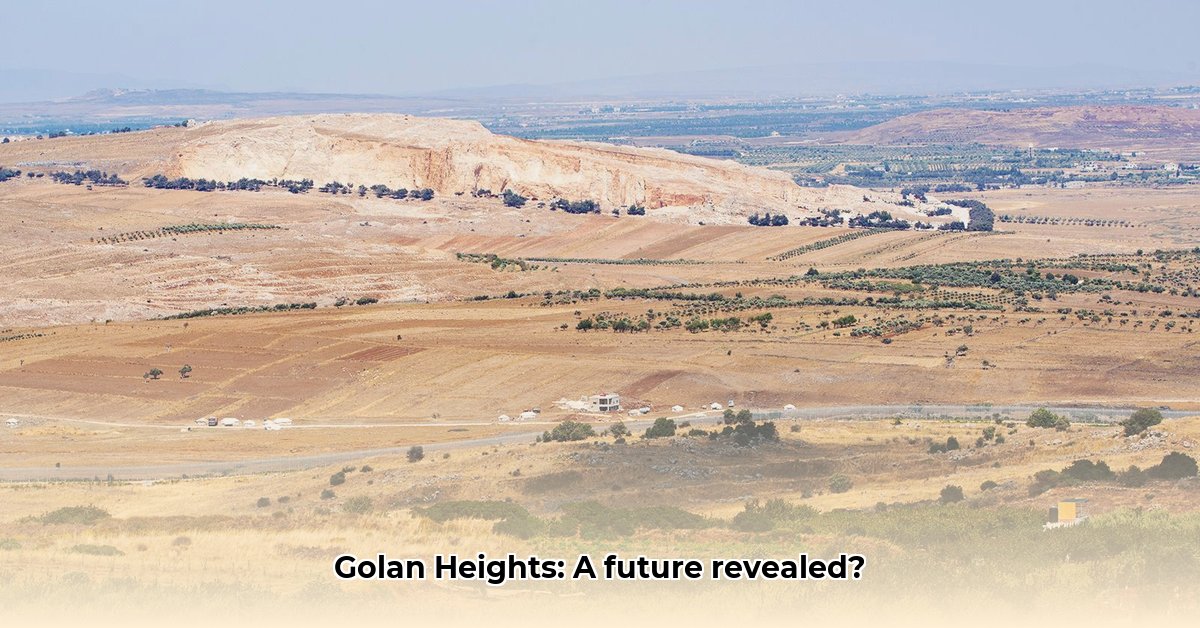
A Land with a Long, Complicated History, and an Even More Complicated Present
The Golan Heights, a plateau overlooking the Sea of Galilee, boasts a history stretching back millennia. Assyrians, Romans, and Ottomans, among others, all coveted this strategic location. Its geographical prominence, controlling vital routes and resources, has made it a consistent flashpoint for conflict. This small area carries immense geopolitical weight, impacting the lives of all who inhabit it. But how has this weight manifested itself in the lives of the people actually living there?
The Six-Day War: A Pivotal Moment
The 1967 Six-Day War fundamentally reshaped the Golan Heights' destiny. Israel's seizure of the region dramatically altered the regional power balance, displacing countless residents and upending countless lives. Israel's 1981 annexation, albeit unrecognized by most of the international community, remains a deeply contentious issue, fueling ongoing tensions between Israel and Syria. The scars of this war remain visible – aren't they a stark reminder of the ongoing instability?
The Druze: A Community Caught Between Worlds
The Druze community, with its unique religious and cultural identity, finds itself in a precarious position. Historically linked to Syria, they now live under Israeli rule. This duality creates a daily balancing act, testing their loyalties and casting uncertainty over their future. Their voices, their concerns, are crucial to any meaningful path towards lasting peace. How do they navigate this complex reality, safeguarding their cultural heritage while securing their future? Aren't their challenges a microcosm of the broader regional conflicts?
Water: A Precious Resource, a Source of Conflict
Water, particularly in an arid region, constitutes a lifeblood resource. The Golan Heights holds significant water sources, impacting Israel, Syria, Jordan, and the West Bank. Control over this resource equates to control over life itself, making access a constant point of contention, potentially igniting further conflict. How can equitable water sharing be achieved without exacerbating regional tensions? Isn't water management a key to regional peace? A recent study indicated that [Insert statistic from Draft Article about water scarcity/usage in the region], highlighting the urgency of cooperative solutions.
The Future: Navigating Uncertainty
Predicting the future of the Golan Heights is a daunting task. While Israel currently maintains control, with US recognition of its annexation, Syria's claim persists, supported by the United Nations. Reconciliation seems distant, yet opportunities for cooperation exist, particularly in water management and economic development. The path forward demands compromise and a willingness to overcome long-standing grievances. What steps are needed to build that foundation of trust?
Key Players and Their Aspirations
The following table summarises the key stakeholders and their objectives, both short-term and long-term. It is important to note that these are potential goals, and the dynamic nature of the situation might lead to shifts in priorities.
| Stakeholder | Short-Term Goals | Long-Term Goals |
|---|---|---|
| Syria | To exert diplomatic pressure; to pursue international legal avenues | To regain control of the Golan Heights; to restore full sovereignty |
| Israel | To ensure security; to maintain positive relationships with the Druze community | To maintain control of the Golan Heights; to potentially grant greater autonomy to the Druze |
| Druze Community | To protect their land and cultural heritage; to achieve greater security | To ensure stability; to participate fully in the political and economic life of the region |
| International Community | To continue UN resolutions and diplomatic efforts; to promote dialogue | To mediate a peaceful resolution; to assist in sustainable development |
| Neighboring Countries | To cooperate on water management and resource sharing | To build regional stability and prevent further escalation |
The future of the Golan Heights remains uncertain, but not hopeless. The path towards a peaceful and prosperous future requires understanding the diverse perspectives and addressing the challenges faced by all stakeholders. It's a complex issue; there are no easy solutions. However, meaningful progress is possible with a commitment to dialogue and cooperation. The coming years will be crucial in shaping the region's destiny. Ongoing research and continuing dialogue are absolutely essential for building a deeper understanding.
Securing the Future of the Druze Community
Professor Anya Sharma, Director of the Centre for Middle Eastern Studies at the University of Cape Town, notes: “The Druze community's future in the Golan Heights is directly tied to the larger regional political dynamics. Economic self-sufficiency and political inclusion are crucial for their long-term well-being.” This underscores the complexity of the challenges facing the Druze population.
The ongoing conflict and the uncertain future cast a long shadow, but hope exists in finding a way forward that caters to the needs and aspirations of the Druze community. Aren't their experiences a potent reminder of the human cost of protracted conflict? The immediate need is for a more thorough investigation of the issues they face.